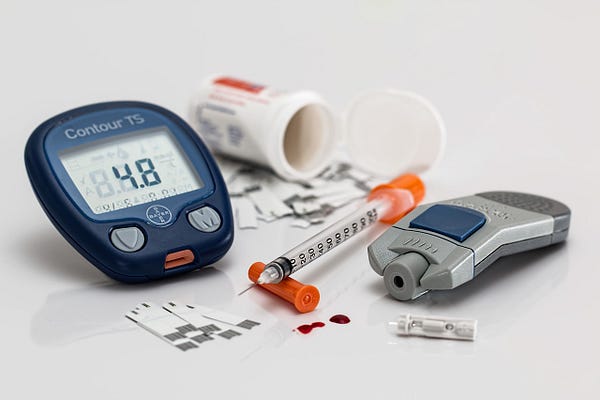
Diabetes has become a global health challenge, affecting millions of lives. Did you know that over 537 million adults worldwide were living with diabetes in 2021, as per the International Diabetes Federation? Alarmingly, this number is expected to rise to 643 million by 2030. Let’s dive into what diabetes is, why it occurs, its types, causes, and how it can be managed or prevented.
What is Diabetes?
Diabetes is a chronic medical condition that affects how your body processes blood sugar (glucose). Glucose is the body’s primary energy source, and insulin, a hormone produced by the pancreas, helps regulate it. In diabetes, the body either doesn’t produce enough insulin or fails to use it effectively, leading to high blood sugar levels.
Why Does Diabetes Happen?
Diabetes occurs due to an imbalance in the body’s ability to regulate blood sugar levels. There are two primary reasons:
- Insufficient Insulin Production: The pancreas fails to produce enough insulin.
- Insulin Resistance: The body’s cells don’t respond effectively to insulin.
Types of Diabetes
1. Type 1 Diabetes (Autoimmune Condition):
- Occurs when the immune system attacks insulin-producing cells in the pancreas.
- Usually diagnosed in children and young adults.
- Requires lifelong insulin therapy.
2. Type 2 Diabetes (Lifestyle-Related):
- The most common form, accounting for 90–95% of all diabetes cases.
- Caused by insulin resistance and often linked to obesity, poor diet, and inactivity.
- Can be managed through lifestyle changes and medication.
3. Gestational Diabetes:
- Develops during pregnancy and usually resolves after childbirth.
- Increases the risk of developing Type 2 diabetes later in life.
4. Prediabetes:
- A condition where blood sugar levels are higher than normal but not high enough to be classified as diabetes.
- A wake-up call for lifestyle changes to prevent Type 2 diabetes.
What Causes Diabetes?
1. Genetic Factors:
- Family history increases the risk.
- Certain ethnicities, like South Asians, have a higher predisposition.
2. Lifestyle Factors:
- Poor diet (high in sugar and processed foods).
- Sedentary lifestyle.
- Obesity, particularly abdominal fat.
3. Medical Conditions:
- Polycystic Ovary Syndrome (PCOS).
- High blood pressure.
- Hormonal imbalances.
4. Environmental Factors:
- Viral infections (in Type 1 diabetes).
- Stress or trauma.
Can Diabetes Be Cured?
Currently, there is no permanent cure for diabetes, but it can be managed effectively. With the right approach, people with diabetes can live healthy, normal lives.
Management Includes:
- Lifestyle Modifications: Healthy eating, regular exercise, and weight management.
- Medications: Insulin or oral drugs.
- Regular Monitoring: Keeping track of blood sugar levels.
Emerging Research:
Medical science is exploring innovative solutions like pancreatic islet transplants and artificial pancreas systems. While promising, these are still in experimental stages.
Exercises for Managing Diabetes
Exercise is one of the most effective ways to manage diabetes. It enhances insulin sensitivity, lowers blood sugar levels, and helps prevent complications associated with diabetes, such as heart disease and nerve damage.
Best Exercises for Diabetes
1. Aerobic Exercises
Examples: Walking, jogging, swimming, cycling, or dancing.
Duration: 30 minutes, 5 days a week (or 150 minutes per week).
Benefits:
- Improves heart health and circulation.
- Lowers blood sugar by increasing glucose uptake by muscles.
- Promotes weight loss and reduces belly fat.
2. Resistance Training
Examples: Weightlifting,Bodyweight exercises (e.g., push-ups, squats, lunges), Resistance band workouts.
Frequency: 2–3 times a week, focusing on all major muscle groups.
Benefits:
- Builds muscle mass, which helps the body use glucose more efficiently.
- Enhances metabolism, making it easier to maintain healthy blood sugar levels.
3. Flexibility and Balance Exercises
Examples: Yoga, pilates, stretching routines, tai chi.
Frequency: 2–3 times per week.
Benefits:
- Reduces stress, which can help lower cortisol and stabilize blood sugar.
- Improves joint mobility, which is beneficial for people with diabetic neuropathy.
- Enhances overall relaxation and blood flow.
Scientific Insight into Exercise and Diabetes
1.Exercise and Glucose Uptake:
- Physical activity increases the ability of muscles to absorb glucose from the bloodstream, even without insulin.
- This effect can last for up to 48 hours after exercise.
2. A1C Reduction:
- Research shows that 150 minutes of moderate aerobic exercise per week can lower A1C levels by 0.6%-0.9%.
3. Weight Loss and Belly Fat Reduction:
- Excess abdominal fat is linked to insulin resistance. Exercise helps reduce visceral fat, improving overall insulin sensitivity.
4. Improved Heart Health:
- Diabetes increases the risk of heart disease. Aerobic and resistance training improve cardiovascular function, lowering blood pressure and cholesterol levels.
Tips to Exercise Safely with Diabetes
- Monitor Blood Sugar:Check blood sugar before and after exercising to ensure it stays within a safe range (70–130 mg/dL before meals).
- Stay Hydrated:Dehydration can affect blood sugar levels. Drink water before, during, and after your workout.
- Wear Proper Footwear:This is essential to prevent injuries or foot ulcers, especially for those with neuropathy.
- Carry Snacks:Have a fast-acting carbohydrate (like glucose tablets or fruit juice) on hand to treat hypoglycemia if your blood sugar drops too low during exercise.
- Start Slow:If you’re new to exercise, begin with low-impact activities like walking or gentle yoga, then gradually increase intensity.
Things to Avoid
- Exercising on an Empty Stomach:Doing so may lead to hypoglycemia, especially if you’re on insulin or other blood sugar-lowering medications.
- Overexertion:High-intensity workouts without proper preparation can cause spikes in blood sugar due to the release of stress hormones.
- Ignoring Foot Care:Always check your feet for sores or blisters after exercising to prevent infections.
- Skipping Warm-Up and Cool-Down:This can lead to injuries or sudden drops in blood pressure.
Conclusion
Incorporating exercise into your routine is essential for managing diabetes effectively. By combining aerobic exercises, resistance training, and flexibility routines, you can significantly improve your blood sugar control, insulin sensitivity, and overall health.
Would you like to explore personalized workout plans or diet tips for diabetes management?
Comments
Post a Comment